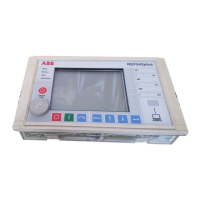Multifunction Protection and Switchgear Control unit REF542plus
Manual: Motor Protection with ATEX-Certification
The heat losses is represented by resistor R
During charging, a voltage is present at the capacitor. The capacitor voltage is again
proportional to the motor temperature. The voltage characteristic can be determined
based on the equation below:
ττ
t
p
t
eRieRtitu
−−
+−= )1()()(
(4.)
Where:
u(t) Voltage characteristic as a function of time,
t Time
i(t) Charging current characteristic as a function of time
R Resistor
τ Time constant resulting from the product of R and C
i
p
Biasing current before the charging process
The time constant for the time-related voltage variation is determined by the capacitor
and the resistor. In accordance with the analogy mentioned above, it is possible to
equate the voltage characteristic with the temperature, the charging current with the
amount of thermal energy supplied, and the biasing current with the heat condition
before the temperature rise. This leads to the equation below for determining the
temperature characteristic:
ττ
ϑϑϑ
t
p
t
eeEt
−−
∆+−∆=∆ )1()()( (5.)
Where:
∆ϑ(E) Time-related characteristic of the temperature change during tempera-
ture rise
t Time
E Heat energy supplied
∆ϑ
p
State of the temperature before temperature rise as a result of preload-
ing
After a transformation, the time required until a certain temperature ∆ϑ (t) is reached
can be determined as follows:
)()(
)(
ln
tE
E
t
p
ϑϑ
τ
∆−∆
∆
=
(6.)
Since the temperature resulting from the temperature rise depends on the amount of
thermal energy supplied - which, in turn, is square-proportional to the current in the
motor - the above equation can be rewritten for the rated motor current like this:
1VTA100114-Rev. 04 en PTMV, 19.01.05 Motorprotection 18 / 66
Valid from Version V4D02

